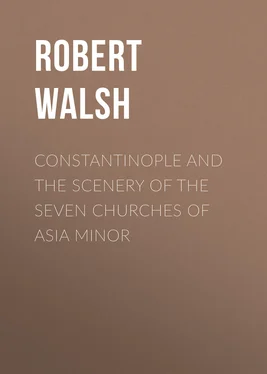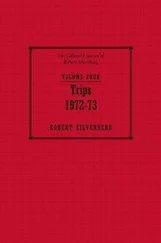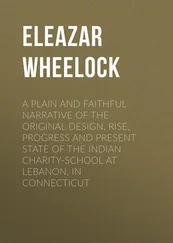Robert Walsh - Constantinople and the Scenery of the Seven Churches of Asia Minor
Здесь есть возможность читать онлайн «Robert Walsh - Constantinople and the Scenery of the Seven Churches of Asia Minor» — ознакомительный отрывок электронной книги совершенно бесплатно, а после прочтения отрывка купить полную версию. В некоторых случаях можно слушать аудио, скачать через торрент в формате fb2 и присутствует краткое содержание. Жанр: foreign_prose, foreign_home, История, foreign_antique, на английском языке. Описание произведения, (предисловие) а так же отзывы посетителей доступны на портале библиотеки ЛибКат.
- Название:Constantinople and the Scenery of the Seven Churches of Asia Minor
- Автор:
- Жанр:
- Год:неизвестен
- ISBN:нет данных
- Рейтинг книги:5 / 5. Голосов: 1
-
Избранное:Добавить в избранное
- Отзывы:
-
Ваша оценка:
- 100
- 1
- 2
- 3
- 4
- 5
Constantinople and the Scenery of the Seven Churches of Asia Minor: краткое содержание, описание и аннотация
Предлагаем к чтению аннотацию, описание, краткое содержание или предисловие (зависит от того, что написал сам автор книги «Constantinople and the Scenery of the Seven Churches of Asia Minor»). Если вы не нашли необходимую информацию о книге — напишите в комментариях, мы постараемся отыскать её.
Constantinople and the Scenery of the Seven Churches of Asia Minor — читать онлайн ознакомительный отрывок
Ниже представлен текст книги, разбитый по страницам. Система сохранения места последней прочитанной страницы, позволяет с удобством читать онлайн бесплатно книгу «Constantinople and the Scenery of the Seven Churches of Asia Minor», без необходимости каждый раз заново искать на чём Вы остановились. Поставьте закладку, и сможете в любой момент перейти на страницу, на которой закончили чтение.
Интервал:
Закладка:
An attempt was made to destroy Selim by a singular poison: Mustapha pasha composed a ball of soap with various aromatic ingredients, but one of so deadly a poison, that, like prussic acid, it was immediately absorbed by the skin, and destroyed the person to whose face it was applied; and this was sent to the sultan’s barber, as a precious invention, to be used when shaving his master. It was accompanied by a packet enclosed in a case of lead; a precaution which excited suspicion, and led to discovery. The pasha, barber, and all connected with them, were strangled, and the sultan escaped. He afterwards died of a foul cancer, in the eleventh year of his reign, having justly acquired the name of Yavuz , “the Ferocious.” He displayed his qualification of poet by writing his own epitaph, which is seen upon his tomb, and describes his “ruling passion, strong in death.”
“The earth I conquered while alive;
In death to combat yet I strive.
Here lies my body, seamed with scars;
My spirit thirsts for future wars.”
Soliman I. (or as he is by some classed II.) is represented as the greatest prince that ever sat upon the Turkish throne; and he obtained the name of “the Magnificent,” for the splendour of his achievements. He commenced his reign in 1520, which lasted forty years; and made three vows, which he hoped to accomplish before his death: to complete the hydraulic works of Constantinople−to erect the finest mosque in the world−and to establish the western capital of Islamism at Vienna. The two first he effected, and nearly succeeded in the last. After conquering all the countries between the Euxine, Caspian, and Red seas, he turned his arms to Europe, in order to accomplish his vows, and penetrated to Vienna, to which he laid siege without success; but he established a strong garrison at Buda, the capital of Hungary, and held possession of it, to renew his attempt. In the mean time, his fleets, united with the piratical states of Barbary, under the banner of Barbarossa, or “Red Beard,” ravaged the shores of the Mediterranean; and captive nobles from Spain, the most western country in Europe, were seen in chains among his slaves at Constantinople. Carrying thus his conquering arms from the Caspian to the Atlantic, and from the centre of Europe to the centre of Africa, there was but one little spot which opposed his plan of universal empire: that spot was the island of Malta. The crusaders had left this single remnant behind them, so excellent and noble as to redeem all their other failings. The knights of St. John had retired from Palestine to Rhodes, and from thence to Malta; and there they stood, the last barrier and bulwark of Christianity against the overwhelming torrent of Turkish dominion. These were now to be exterminated, and their island made the stepping-stone to establish the religion of the Prophet in the western world. The siege which Malta sustained on this occasion is the most gallant and interesting to be found in the records of human actions. The knights amounted but to 700 men; they organized a force of 8000, and with this they had to oppose a fleet of 200 sail, carrying an army of 50,000. After incredible acts of heroism and devotedness, they compelled the Turks to withdraw the remnant of their forces; and the first effectual check was given to their hitherto resistless power.
The character of Soliman, as drawn by historians, is more perfect than that of any other sovereign who occupied the throne of the Osmanli. His love of literature, his enlightened mind, his inviolable faith, placed him in strong contrast with his fellow-sultans; yet his private life is stained with more than Oriental barbarity. He had children by two wives, one of whom was the celebrated Roxalana; the elder, Mustapha, was heir to the throne, and a youth of great promise, but Roxalana was determined to prefer her own, and to that end stimulated Soliman to put Mustapha to death. He sent for him to his tent; and as soon as he entered, caused him to be seized by several mutes, who were in waiting with a bowstring to strangle him. The young man made a vigorous resistance, when the father, fearing he might escape, raised his head above the canvass partition of the tent, and with menacing gestures threatened the mutes with his vengeance if they did not despatch him. The unhappy youth caught his father’s eye, and passively submitted to his fate. He was strangled, and his body thrown on a carpet, to be exposed in front of the tent. Mustapha had yet another brother, whom it was necessary to dispose of also. He was a mere boy, and, as his mother kept him carefully secluded within the walls of her apartments, the wily Kislar Aga, who was sent to visit her, was obliged to have recourse to stratagem to separate them. He represented to the mother that Soliman was tortured with remorse for the death of her eldest son, and wished to repair his fault by affection for the younger. He was afraid his health would suffer by confinement, and it was his wish that he and his mother should take air and exercise; and for this purpose a horse, splendidly caparisoned, was sent for the boy, and an arrhuba for herself and her female slaves. The credulous mother was persuaded, and they set out to visit a beautiful kiosk on the shores of the Bosphorus. The boy rode on “in merry mood,” with the Kislar Aga, and she followed in the arrhuba. When arrived at a rough part of the road, the carriage, which had been previously prepared, broke down, and the truth instantly flashed upon the wretched mother’s mind; she sprung out, and rushed after her son, who had by this time entered the kiosk with his companion. She arrived breathless, and found the door closed; she beat at it with frantic violence, and when at length it was opened, the first object that presented itself, was her only remaining son, lying on the ground, strangled, his limbs yet quivering in his last agonies, and the bowstring of the eunuch yet unloosed from his throat.
The last years of the wretched old man were imbittered by the conduct of the sons, for whose advancement he had suffered those foul murders to be committed. His son Bajazet was a rebel to his father’s authority; and Selim, who succeeded him, was the most weak and wicked of the Mohammedan line. His noble mosque, and the tombs that contain the ashes of himself and his wife Roxalana, are shown by the Turks to strangers as the most splendid monuments left by their sultans.
Selim II. succeeded to the throne in 1566, and was entirely devoted to the gratification of his appetites. His father was temperate in wine, and forbade its use under the severest penalties. It is said he attributed the failure of the attack on Malta to the violation of the law of Mohammed in this respect, and he caused caldrons of boiling oil to be kept in the streets, ready to be poured down the throat of any person, Turk, Jew, or Christian, who was found intoxicated. Selim, as if in contempt and mockery of his father, indulged in wine to such excess, that he despatched an expedition to Cyprus, and annexed that island to the empire, for no other reason but because it produced good wine. The loss of the sanguinary battle of Lepanto, in his reign, was another blow following the defeat at Malta, which shook the mighty fabric of the Turkish empire. Selim died after a reign of eight years and five months, a rigid observer of all the Prophet’s laws, except sobriety.
The people of the West had now begun to recover from the terror which the first eruption of these terrible barbarians into Europe had excited, and to consider the many commercial advantages to be derived from an intercourse with them. The French and Venetians, in the reign of Selim, had already established this intercourse; and the English were supplied with Oriental produce by the latter, who sent Argosies, or ships of Ragusa, in the gulf of Venice, to England, freighted with the wealth of the East. One of these rich vessels was wrecked on the Goodwin sands, and the Venetians were afraid to send another. But the English having tasted of Asiatic luxuries, could not dispense with them; and the enterprising Elizabeth, in whose reign the accident happened, sent Raleigh and Drake to explore the West, while Harebone was despatched to open a communication with the East. She wrote a Latin letter, addressed, Augustissimo invictissmoq. principi Sultan Murad Can ; in which she seems not only to prize highly the incipient reformation in England, but also to recommend herself to the Turk by a principle common to Islamism, “an unconquerable opposition to idolatry.” Her letter was well received, and Sir E. Barton was appointed her first resident ambassador. He accompanied Amurath in his Hungarian wars, and died on his return to Constantinople. He was buried in the island of Chalki, and his monument still exists in a Greek convent there. Hence originated an English residence at Constantinople, and the establishment of the Levant Company, a body of merchants who, for 240 years, have caused the name of England to be respected in the East, among the most honoured nations of Europe.
Читать дальшеИнтервал:
Закладка:
Похожие книги на «Constantinople and the Scenery of the Seven Churches of Asia Minor»
Представляем Вашему вниманию похожие книги на «Constantinople and the Scenery of the Seven Churches of Asia Minor» списком для выбора. Мы отобрали схожую по названию и смыслу литературу в надежде предоставить читателям больше вариантов отыскать новые, интересные, ещё непрочитанные произведения.
Обсуждение, отзывы о книге «Constantinople and the Scenery of the Seven Churches of Asia Minor» и просто собственные мнения читателей. Оставьте ваши комментарии, напишите, что Вы думаете о произведении, его смысле или главных героях. Укажите что конкретно понравилось, а что нет, и почему Вы так считаете.












